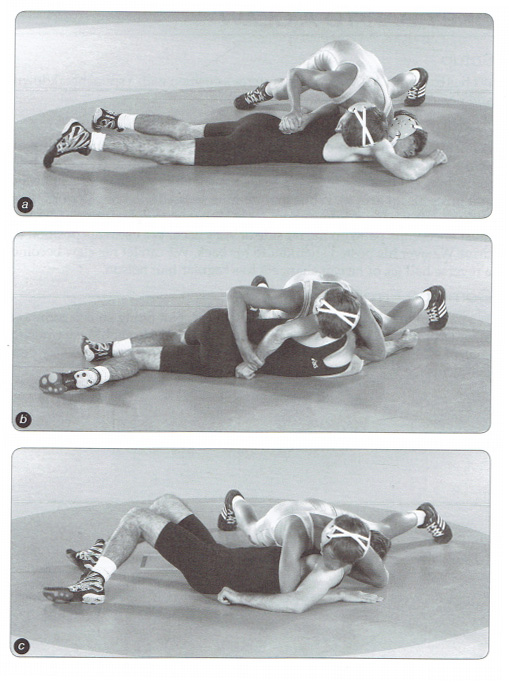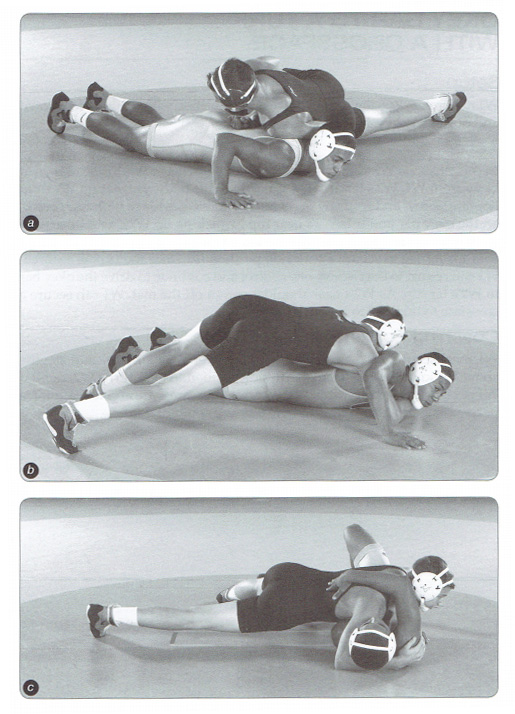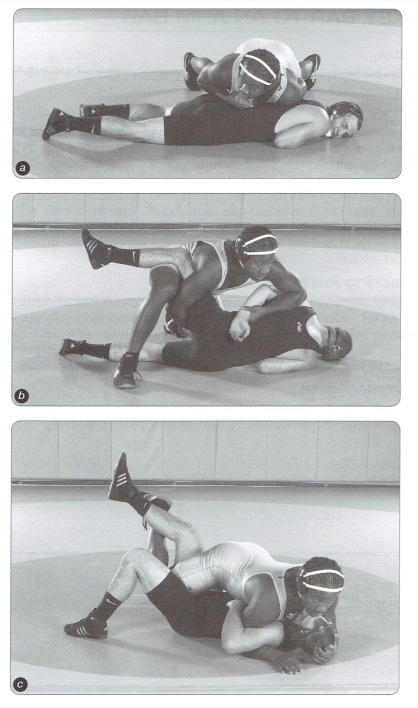| Okey Bar Drills |
| By: Bill Welker
Originally Published in: The Wrestling Drill Book Provided by: Human Kinetics Setup W1 has broken W2 down from the referee's position with a spiral breakdown and posted W2's near arm across his back. Action While maintaining two-on-one control of W2's arm, W1 drives W2's arm across his back at an angle towards W2's far hip, keeping W2's arm close to his back (a). As W2's near shoulder comes up off of the mat, W1 drops his top shoulder below W2's near shoulder (b) . As he continues to drive W2's arm towards his far hip, W1 gives up his two-on-one control. W1 then applies a half nelson with his top arm and continues to drive W2 to his back. As W2 turns to his back, W1 can release the okey bar and slide his bottom arm to an underhook position (c) to prevent W2 from turning out of the pinning combination. Coaching Points W1 must remain perpendicular to W2 after securing the okey bar. W1 must allow W2's controlled wrist to rotate so that his near shoulder can come away from the mat. Maintaining pressure on W2's back while driving his arm to his far hip is an important aspect to successful completion of this pinning combination. Common Error Not keeping pressure on the defensive wrestler's back is a common mistake.
OKEY BAR TO A CLAW Setup W1 has broken W2 down from the referee's position with a spiral breakdown and posted W2's near arm across his back. Action While maintaining two-on-one control of W2's arm, W1 drives W2's arm across his back at an angle towards W2's far hip, keeping W2's arm close to his back. In this instance, W2 turns his shoulder down, his head away, and posts his far arm (a) . While maintaining pressure, W1 hops across W2's body and drives his bottom arm under W2's armpit to a claw position (b). W1 must anchor his palm on the far side of W2's neck. W1 uses this position to drive W2 over his posted shoulder to his back. W1 can let his claw become a reverse half (c), or he can change it to a regular half nelson. Common Error W1 must maintain pressure as he hops across. Not doing so is a common error that must be carefully observed by the coach. He should continue to control W2's arm, even after W2 has been turned to his back, and stay perpendicular to W2 while attempting to secure the fall.
OKEY BAR TO A TURK WITH A CROSSFACE Setup W1 has broken W2 down from the referee's position with a spiral breakdown and posted W2's near arm across his back. Action In this situation W2 keeps his near shoulder down and has his head turned away from W1. W2's far arm is kept close to his body, preventing W1 from hopping across and securing the claw (a) . W1 releases his two-on-one control on the okey bar and lifts W2's near hip by picking up W2's near knee with his low arm. As space is created, W1 then steps under W2's near leg and over his far leg to secure a turk ride position (b) . Once the turk is secured, WI can return to the two-on-one control and continue to drive the okey bar to W2's far hip. As W2's near shoulder comes off the mat, W1 can secure a crossface to take W2 to his back (c). Coaching Points W1 must secure the turk ride by stepping over W2's far knee and staying above the knee for an effective turk ride position. As W1 turns W2, remind W1 to circle the turk towards W2's head to keep pressure and to maintain a perpendicular position through the pinning combination.
|









